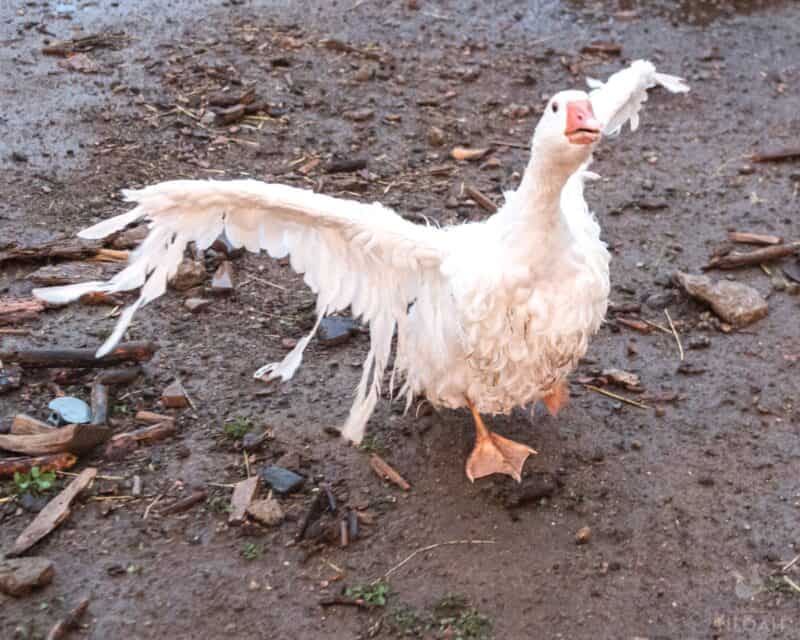If you ever watched waterfowl closely out in the wild, you probably noticed that from time to time they stand on one leg. They certainly don’t seem to struggle with balance issues!

And some birds that do this a lot are geese, both domestic and wild breeds. It’s interesting, even a little charming, but why do these birds do it in the first place? Why do geese stand on one leg sometimes?
Standing on one leg allows geese to stay warmer by minimizing heat loss to the surface they are standing on, and also stay warmer by tucking one of their legs close to their body.
It really is that simple. Due to their biology, geese tend to stay quite warm no matter how frigid the conditions are outside, even when they are in freezing cold water. However, they aren’t invulnerable and in time they can lose too much body heat and go hypothermic.
Standing on one leg allows them to keep a leg and foot from getting too cold, but it also helps keep these birds warmer overall. Keep reading and I’ll tell you all about it.
Standing on One Leg Reduces Heat Loss from Contact with Cold Ground or Water
One major cause of body heat loss for animals is through conduction. Basically, when anything warm is in contact with anything colder than it is, the heat wants to migrate into the colder surface until the temperatures are equalized.
Obviously, in the case of something like a huge body of water or even the Earth itself, all it will ever do is continually suck the heat out of a warm body. This is why you never want to sleep in direct contact with the ground out in nature. It’s the same thing for geese!
Considering that their legs also don’t have an envelope of insulating feathers around them, they are particularly vulnerable to getting too cold, even with their special adaptations that prevent their legs from freezing too quickly.
By taking one of their legs out of contact with the surface, be it the water or soil, that heat “leak” is halted, at least partially!
Pulling a Leg Into Their Feathers Helps Geese Stay Warmer, Too!
As mentioned, geese have a remarkable adaptation to help keep their legs warm and in turn, maintain their body heat overall. This is accomplished by having the arteries in the legs, carrying warmer blood from the heart, in contact with the veins in the legs that return the cooler blood to the trunk.
This amazing and remarkably efficient system allows geese to weather even the most frigid conditions.
But, by pulling the one leg up and against their body, or even inside the protective feathers they have, that leg will stay much warmer, and if it is staying warmer that means that the body of the goose is going to maintain a higher and more consistent temperature.
Geese Will Switch Legs When One Gets Too Tired or Cold
Obviously, the geese have to make a choice here when standing. One leg or the other is going to be exposed and, naturally, colder than the other.
That’s just the way it is, but don’t worry about them, because when one leg gets too cold, or a leg gets too tired, a goose will shift its weight to the other leg, drawing the chilly one up close to their body where it will quickly warm.
Simply by alternating legs in this way, geese can prevent frostbite and fatigue assuming they have to stand, and sometimes they do!
Some Geese Might Even Sleep Standing on One Leg!
Many birds, and even some geese on occasion, have been known to sleep standing on one leg. It’s true! They employ this unique perching behavior for the same reason discussed above: it helps them stay warmer, especially if they have to try and sleep on damp or soggy ground.
You can watch for your geese to use this technique if the ground is very cold. They’ll tuck their head and beak down into their wing as usual, too.
Keep an Eye on Lifted Legs for Injuries
One last thing: if you have geese of your own you don’t have to be alarmed if you see them pulling their leg up to stand on it for any length of time, especially when the weather is really terrible.
However, do keep an eye on them as they move around, or if they start exhibiting this behavior when the weather is mild. It might be an indication that your goose is suffering from an injury, either bumblefoot, a cut or puncture, or that they have something stuck in their foot.
In this case, make sure you check them over carefully for any injuries or anything else that might be out of place.
Tom has lived and worked on farms and homesteads from the Carolinas to Kentucky and beyond. He is passionate about helping people prepare for tough times by embracing lifestyles of self-sufficiency.
